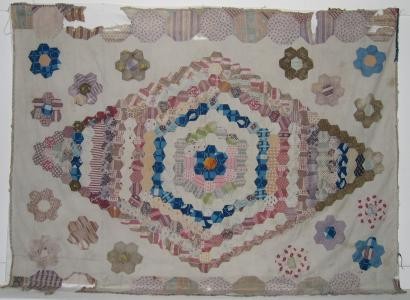2004-3 patchwork fragment

This is a patchwork fragment of hexagons pieced over paper – probably the centre from a larger quilt. Some of the fabrics date from the 1830s, 40s and 50s.
The hexagons have been pieced over paper and handsewn together. One paper remains. The fragment was acquired from a charity shop in Llanidloes. It is in poor condition, especially around the edges where it is torn and worn. Nevertheless it contains some interesting fabrics from the mid 19th century, which provided the basis of workshop study in September 2009 with Dr Philip Sykas, Research Associate at Manchester Metropolitan University.
Chrome yellow and orange originate from about 1830. The central hexagon is very bright, and it has centre of place implying that it was very special fabric.
There are a number of other fabrics from the 1830s – fine roller prints. They are cashmere-esque designs, with fine trails, and very geometric. They have a fine thread count.
The Prussian blues are typical of the 1840s. The dye is applied more heavily and is not as susceptible to fading, thus it remains strong.
There are single purple fabrics from the 1840s, which took over from indigo in popularity at this time. This fabric was worn as a day dress indoors by the middle classes – but not worn to go out in. After the 1840s it was seen as a lesser fabric as a whole. There are also two purple fabrics, where the lighter shade is formed by stippling. In the 1830s the ability to apply two colours on a roller was developed by engraving deeper.